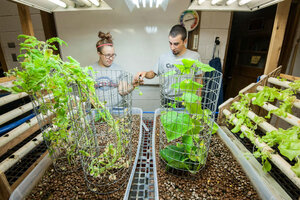Food insecurity lessened through the use of aquaponics
Students at the University of Ottowa have developed a possible solution to food insecurity in the far northern regions of Canada through the use of aquaponics technology.

Students build an aquaponics system at a school in McGaheysville , Va.
Nikki Fox/Daily News-Record/AP/File
Students at the University of Ottawa recently developed The Growcer, an initiative that uses abandoned shipping containers to grow food to improve access to fresh foods such as fruits, vegetables, and fish by using aquaponics in Iqaluit, Nunavut.
The Growcer is a social enterprise that tries to provide consumers with fresh, nutritious food produced in Iqaluit. The project hopes to allow people to purchase fruits, vegetables, and fish at an affordable cost. It involves using abandoned shipping containers to build the aquafarms.
Aquaponics technology combines hydroponics and aquaculture. The initiative uses a farming system that involves raising fish and producing plants in the water. One of the main components of the system is the fish. The by-products of the fish are degraded, which are used as nutrients to produce food in the aquafarm. The aquafarm is designed as a “closed loop” system that reuses the water, ensuring that the water does not need to be constantly reheated during the process.
Iqaluit is a city located in Nunavut, Canada. The harsh northern climate of Nunavut limits the level of food production, which means that these communities are dependent on food imports from the southern regions. For example, in 2013, around 48 kilograms of food were produced in greenhouses in Iqaluit.
One of the main issues is the cost of shipping products to northern communities. In Nunavut, it is six to ten times more expensive to ship products by air than using trucks.
“People rely on expensive shipments from the South,” said Corey Ellis, a student and a member of the group. “We want to provide them with a tool that empowers them to grow their own food and reduces reliance on imports.”
The high cost of shipping affects the cost of food in these communities. The Nunavut Bureau of Statistics conducted a price survey, which included ten communities in Nunavut. According to the price survey, the cost of one liter of milk was 38 percent higher than the national average in March and April 2013. It also found that, on average, the cost of onions was 233 percent more expensive per kilogram, and the cost of celery was 287 percent more expensive per kilogram.
The initiative has three main goals, which include improving the food security of people, promoting health and wellness education, and increasing work opportunities in the community.
Food insecurity is a large issue in Canada, especially in Nunavut. Around 69 percent of Inuit homes are food insecure in Nunavut. The household food insecurity rate in Nunavut is more than eight times higher than the national average.
“The rates in the North suggest a state of emergency,” said Valerie Tarasuk, a professor at the University of Toronto.
With the project, people will be able to purchase fruits and vegetables produced locally during the year. The group hopes that by improving access to fresh food, communities will become less dependent on imports to survive, and they will also have access to a wide variety of foods.
Another goal of the initiative is to promote health and wellness education in the community. They will collaborate with local partners and organizations to develop programs to support a healthy lifestyle. The project will also promote local projects such as healthy cooking initiatives and other events.
There is currently a government-funded initiative designed to reduce food insecurity in northern communities. The program is called Nutrition North Canada and it provides subsidies to reduce the cost of food.
The pilot project is planned to begin this fall and they expect to produce more than a ton of fresh fruits, vegetables, and fish every year. In general, aquafarms tend to develop slowly, and green vegetables start growing before non-green vegetables such as carrots and tomatoes.
Volunteers will initially manage the pilot project. The initiative will later become a source of employment for people in Iqaluit. In Nunavut, the unemployment rate is around 17.9 percent while the national average is around 6.6 percent.
“We plan to train people for the technical jobs and to hire people from the men’s shelter in Iqaluit for the planting and cultivation,” said Ellis. “The homeless rate is one-in-three there, so we’re hoping to provide people with jobs and help them transition back into the work world.”
Currently, the pilot project relies on hydroelectric power and some solar panels. Ellis explains that the goal of the initiative is to become sustainable to ensure that people can produce fresh food during the year.
“It’s a lofty goal, but one day we hope future Growcers will be fully off-grid,” said Ellis.
This article first appeared at Food Tank.

